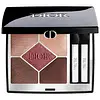bareMinerals Eco-Beautiful Talc-Free Eye & Cheek Palette Versus Dior 5 Couleurs Couture Eyeshadow Palette
What's inside
What's inside
 Key Ingredients
Key Ingredients

 Benefits
Benefits

 Concerns
Concerns

 Ingredients Side-by-side
Ingredients Side-by-side

Mica
Cosmetic ColorantMicrocrystalline Cellulose
AbsorbentCaprylic/Capric Triglyceride
MaskingBis-Diglyceryl Polyacyladipate-2
EmollientDiisostearyl Malate
EmollientPhenyl Trimethicone
Skin ConditioningDimethicone
EmollientDimethicone/Vinyl Dimethicone Crosspolymer
Skin ConditioningEthylhexylglycerin
Skin ConditioningCaprylyl Glycol
EmollientTin Oxide
AbrasiveSodium Dehydroacetate
PreservativePhenoxyethanol
PreservativeIron Oxides
CI 77891
Cosmetic ColorantCI 77007
Cosmetic ColorantCalcium Aluminum Borosilicate
Cucumis Sativus Fruit Extract
EmollientBoron Nitride
AbsorbentSilica
AbrasiveCaffeine
Skin ConditioningBorago Officinalis Seed Oil
EmollientCalcium Sodium Borosilicate
Synthetic Fluorphlogopite
CI 77510
Cosmetic ColorantCI 77742
Cosmetic ColorantBlue 1 Lake
Cosmetic ColorantCI 77289
Cosmetic ColorantIsopropyl Myristate
EmollientCI 77163
Cosmetic ColorantPolymethylsilsesquioxane
Trimethylsiloxysilicate
EmollientLauroyl Lysine
Skin ConditioningMica, Microcrystalline Cellulose, Caprylic/Capric Triglyceride, Bis-Diglyceryl Polyacyladipate-2, Diisostearyl Malate, Phenyl Trimethicone, Dimethicone, Dimethicone/Vinyl Dimethicone Crosspolymer, Ethylhexylglycerin, Caprylyl Glycol, Tin Oxide, Sodium Dehydroacetate, Phenoxyethanol, Iron Oxides, CI 77891, CI 77007, Calcium Aluminum Borosilicate, Cucumis Sativus Fruit Extract, Boron Nitride, Silica, Caffeine, Borago Officinalis Seed Oil, Calcium Sodium Borosilicate, Synthetic Fluorphlogopite, CI 77510, CI 77742, Blue 1 Lake, CI 77289, Isopropyl Myristate, CI 77163, Polymethylsilsesquioxane, Trimethylsiloxysilicate, Lauroyl Lysine
Squalane
EmollientSynthetic Fluorphlogopite
Mica
Cosmetic ColorantSilica
AbrasiveCaprylic/Capric/Succinic Triglyceride
EmollientDimer Dilinoleyl Dimer Dilinoleate
EmollientZinc Stearate
Cosmetic ColorantPolyglyceryl-2 Triisostearate
EmulsifyingRosa Canina Fruit Oil
EmollientTrihydroxystearin
Skin ConditioningCaprylyl Glycol
EmollientCentaurea Cyanus Flower Water
Skin ConditioningSodium Dehydroacetate
PreservativeGlyceryl Caprylate
EmollientEthylhexylglycerin
Skin ConditioningPinus Pentaphylla Seed Oil
EmollientTin Oxide
AbrasiveStearic Acid
CleansingWater
Skin ConditioningSodium Benzoate
MaskingPotassium Sorbate
PreservativeTocopherol
AntioxidantCI 77491
Cosmetic ColorantCI 77492
Cosmetic ColorantCI 77499
Cosmetic ColorantCI 77891
Cosmetic ColorantCI 77000
Cosmetic ColorantCI 77007
Cosmetic ColorantSqualane, Synthetic Fluorphlogopite, Mica, Silica, Caprylic/Capric/Succinic Triglyceride, Dimer Dilinoleyl Dimer Dilinoleate, Zinc Stearate, Polyglyceryl-2 Triisostearate, Rosa Canina Fruit Oil, Trihydroxystearin, Caprylyl Glycol, Centaurea Cyanus Flower Water, Sodium Dehydroacetate, Glyceryl Caprylate, Ethylhexylglycerin, Pinus Pentaphylla Seed Oil, Tin Oxide, Stearic Acid, Water, Sodium Benzoate, Potassium Sorbate, Tocopherol, CI 77491, CI 77492, CI 77499, CI 77891, CI 77000, CI 77007
Ingredients Explained
These ingredients are found in both products.
Ingredients higher up in an ingredient list are typically present in a larger amount.
Caprylyl Glycol is a humectant and emollient, meaning it attracts and preserves moisture.
It is a common ingredient in many products, especially those designed to hydrate skin. The primary benefits are retaining moisture, skin softening, and promoting a healthy skin barrier.
Though Caprylyl Glycol is an alcohol derived from fatty acids, it is not the kind that can dry out skin.
This ingredient is also used as a preservative to extend the life of products. It has slight antimicrobial properties.
Learn more about Caprylyl GlycolThis pigment is called Ultramarine blue lazurite. It gives a saturated blue color, but can be used to create other colors as well.
According to the manufacturer, it is usually made from kaolin, sodium sulfate, sodium carbonate, sulfur, and charcoal.
Ci 77891 is a white pigment from Titanium dioxide. It is naturally found in minerals such as rutile and ilmenite.
It's main function is to add a white color to cosmetics. It can also be mixed with other colors to create different shades.
Ci 77891 is commonly found in sunscreens due to its ability to block UV rays.
Learn more about CI 77891Ethylhexylglycerin (we can't pronounce this either) is commonly used as a preservative and skin softener. It is derived from glyceryl.
You might see Ethylhexylglycerin often paired with other preservatives such as phenoxyethanol. Ethylhexylglycerin has been found to increase the effectiveness of these other preservatives.
Mica is a naturally occurring mineral used to add shimmer and color in cosmetics. It can also help improve the texture of a product or give it an opaque, white/silver color.
Serecite is the name for very fine but ragged grains of mica.
This ingredient is often coated with metal oxides like titanium dioxide. Trace amounts of heavy metals may be found in mica, but these metals are not harmful in our personal products.
Mica has been used since prehistoric times throughout the world. Ancient Egyptian, Indian, Greek, Roman, Aztec, and Chinese civilizations have used mica.
Learn more about MicaSilica, also known as silicon dioxide, is a naturally occurring mineral. It is used as a fine, spherical, and porous powder in cosmetics.
Though it has exfoliant properties, the function of silica varies depending on the product.
The unique structure of silica enhances the spreadability and adds smoothness, making it a great texture enhancer.
It is also used as an active carrier, emulsifier, and mattifier due to its ability to absorb excess oil.
In some products, tiny microneedles called spicules are made from silica or hydrolyzed sponge. When you rub them in, they lightly polish away dead skin layers and enhance the penetration of active ingredients.
Learn more about SilicaThis ingredient is a preservative with antimicrobial properties. It is the sodium salt of dehydroacetic acid.
It is especially effective at preventing bacterial and fungal growth in low concentrations.
Synthetic Fluorphlogopite is the synthethic version of mica. It consists of fluorine, aluminum and silicate.
Synthetic Fluorphlogopite is used to add volume to products.
It is considered non-irritating on the skin.
Learn more about Synthetic FluorphlogopiteTin Oxide is an inorganic oxide used to add opacity and volume to a product. In nature, it is already found in mineral form. The main ore of tin is an opaque and shiny mineral called casseterite.
Tin Oxide helps remove translucency in a product, or make it more opaque. Besides adding opacity, tin oxide is used for bulking to add volume.